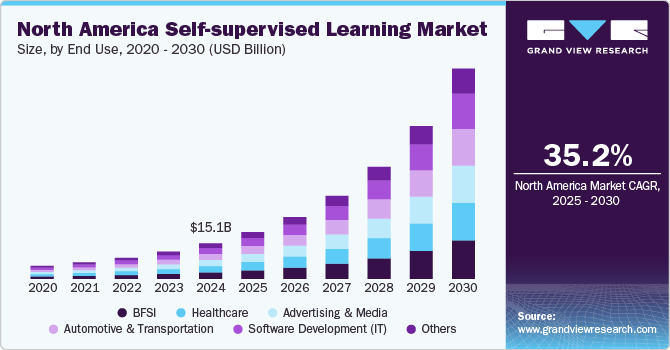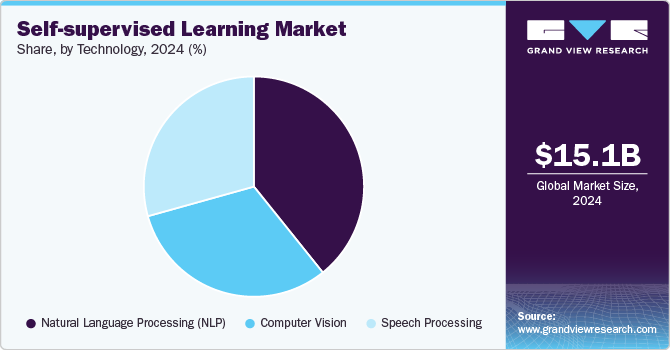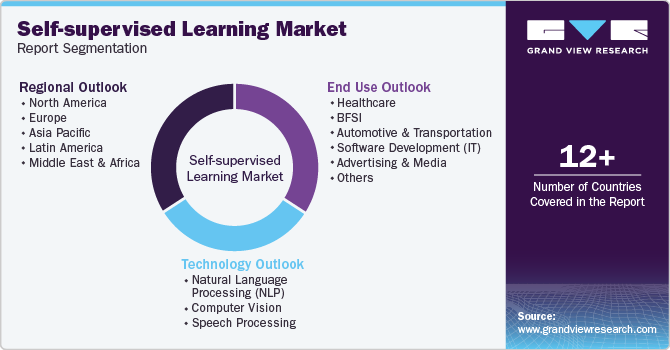
Self-supervised Learning Market Size, Share & Trends Analysis Report By End Use (Healthcare, BFSI), By Technology (Natural Language Processing, Computer Vision), By Region, And Segment Forecasts, 2025 - 2030
- Report ID: GVR-4-68039-971-4
- Number of Report Pages: 100
- Format: PDF
- Historical Range: 2018 - 2023
- Forecast Period: 2025 - 2030
- Industry: Technology
Self-supervised Learning Market Trends
The global self-supervised learning market size was estimated at USD 15.09 billion in 2024 and is projected to grow at a CAGR of 35.2% from 2025 to 2030. The market is experiencing rapid growth, driven by advancements in artificial intelligence (AI) and machine learning (ML). Companies are increasingly adopting self-supervised learning models due to their ability to work with large datasets without the need for extensive human-labeled data. This approach has proven particularly useful in fields such as natural language processing (NLP) and computer vision, where large volumes of unstructured data are common. By reducing reliance on labeled datasets, self-supervised learning offers cost and time efficiency, making it attractive to businesses seeking to optimize AI-driven processes.

The rising need for systems that can learn from limited data is another factor contributing to the market's growth. Self-supervised learning addresses this requirement by allowing models to extract meaningful features from unlabelled data, enhancing their predictive power. This capability is critical for industries such as healthcare, where data scarcity or high labeling costs can be challenging. Moreover, the flexibility of self-supervised learning to adapt to various data types and tasks gives it a competitive edge. As organizations strive to make sense of their growing data pools, the value of self-supervised learning becomes more evident. Advances in computational power and cloud computing are further enabling the scalability of these models. Consequently, companies that adopt self-supervised learning are better positioned to capitalize on the potential of AI and ML.
The expansion of the market is not limited to technology-driven sectors but extends to industries such as finance, retail, and manufacturing. These industries are using the technology to enhance customer experiences, improve operational efficiencies, and develop innovative products. For example, applications such as fraud detection, inventory management, and predictive maintenance benefit from the adaptability of self-supervised learning models. Moreover, the global push toward digital transformation and the rise of data-centric business strategies are accelerating the adoption of AI technologies. The market is also being shaped by increasing investments in AI research and development as organizations seek to stay competitive in a rapidly evolving landscape.
End Use Insights
The BFSI segment dominated the market in 2024 with a market share of 18.3%. The BFSI sector dominated the market because it handles vast amounts of unstructured data, such as customer information, transaction records, and fraud patterns. Self-supervised models help in analyzing this data efficiently without the need for extensive manual labeling. The technology enables advanced predictive analytics, enhancing risk management, fraud detection, and personalized customer experiences. Moreover, BFSI institutions prioritize automation and data security, both of which are supported by these AI-driven models. The demand for real-time insights and operational efficiency further drives the adoption of self-supervised learning in this sector.
The Advertising & Media segment is anticipated to register lucrative growth over the forecast period. This likely growth can be attributed to its need to analyze massive amounts of unstructured data such as user behavior, content, and trends. Self-supervised models help in generating insights without requiring labeled datasets, making it easier to personalize content and target audiences effectively. As companies shift toward data-driven marketing strategies, the ability to optimize campaigns using these models becomes a competitive advantage. Moreover, self-supervised learning aids in improving recommendation systems and content moderation, both critical in this field. The push for enhanced consumer engagement and better ROI is fueling growth in this segment.
Technology Insights
The natural language processing segment accounted for the dominant share in 2024 due to its ability to handle vast amounts of unstructured text data across multiple industries. Self-supervised models allow NLP systems to learn language patterns, semantics, and relationships without relying on extensive human-labeled data, significantly improving efficiency. This technology powers applications such as chatbots, translation services, and sentiment analysis, all of which benefit from continuous advancements in NLP models. Moreover, NLP enhances customer service, automating responses and enabling personalized communication at scale. Its wide applicability and the need for real-time language understanding make NLP a leading segment in the market.

The speech processing segment is anticipated to grow at a significant CAGR over the forecast period because of its role in powering voice assistants, automated transcription, and speech recognition systems. Self-supervised learning enables these models to learn from large amounts of unlabelled audio data, improving accuracy without requiring extensive manual labeling. This growth is driven by the increasing demand for voice-activated technologies and their integration into everyday devices. Moreover, advancements in speech recognition and natural language understanding are making these systems more accessible and efficient. The rise of voice-based search, virtual assistants, and smart devices has further accelerated the adoption of speech-processing technologies.
Regional Insights
North America self-supervised learning market led globally in 2024 with the largest revenue share of 35.7% in 2024. In North America, the market is growing due to increased adoption across industries such as healthcare, finance, and retail. Companies in this region are utilizing AI-driven models to handle large datasets, improving efficiency and decision-making processes. Investments in AI research and development from private and public sectors are accelerating innovation in self-supervised learning technologies. Moreover, the availability of advanced infrastructure and cloud computing capabilities supports the scalability of these models.

U.S. Self-supervised Learning Market Trends
The U.S. self-supervised learning market growth is driven by its leadership in AI research, with strong contributions from tech giants and startups. The country is seeing widespread adoption of AI technologies in sectors such as defense, financial services, and healthcare. The U.S. government’s support for AI initiatives, including funding and regulatory frameworks, has further encouraged market expansion. Self-supervised learning's ability to handle unstructured data is particularly appealing for businesses focused on innovation and personalized services.
Europe Self-supervised Learning Market Trends
The self-supervised learning market in Europe is expanding due to the region's focus on ethical AI use and data privacy. European countries are adopting AI technologies while ensuring they comply with stringent data protection regulations, such as GDPR. The region's emphasis on responsible AI practices is influencing the development of self-supervised models that prioritize transparency and fairness. Moreover, Europe’s push toward digital transformation and AI-driven innovation is creating opportunities in sectors such as manufacturing, healthcare, and finance.
Asia Pacific Self-supervised Learning Market Trends
The Asia Pacific self-supervised learning market is growing rapidly, driven by strong government initiatives to promote AI development and digital transformation. Countries such as China, Japan, and South Korea are investing heavily in AI research and infrastructure, encouraging the adoption of advanced technologies across industries. The region's diverse and massive data sets provide many opportunities for self-supervised learning models to thrive, particularly in sectors such as e-commerce, telecommunications, and healthcare. The competitive tech landscape and demand for automation are further accelerating the integration of AI-driven solutions.
Key Self-supervised Learning Company Insights
Some of the key companies in the Self-supervised Learning industry include IBM Corporation, Alphabet Inc. (Google LLC), Microsoft, Amazon Web Services, Inc., and others. Organizations are focusing on increasing customer base to gain a competitive edge in the industry. Therefore, key players are taking several strategic initiatives, such as mergers and acquisitions and partnerships with other major companies.
-
IBM offers advanced self-supervised learning models that enable AI to learn from large, unlabeled datasets, reducing the need for extensive manual input. Its solutions focus on areas such as natural language processing (NLP) and computer vision, enhancing automation and data analysis for businesses. Through platforms such as Watson, IBM integrates self-supervised learning into enterprise tools, offering improved decision-making and operational efficiency. Moreover, IBM ensures its AI models prioritize ethical data use, promoting transparency and fairness in AI applications.
-
Microsoft offers self-supervised learning solutions through its Azure AI platform, enabling businesses to leverage AI models that learn from vast amounts of unlabelled data. These models are integrated into tools such as Azure Cognitive Services, which enhance natural language processing (NLP), speech recognition, and image analysis capabilities. Microsoft’s focus on self-supervised learning helps improve automation, personalized services, and real-time data processing for various industries. Moreover, the company prioritizes responsible AI development, ensuring transparency, fairness, and compliance with ethical standards across its AI offerings.
Key Self-supervised Learning Companies:
The following are the leading companies in the self-supervised learning market. These companies collectively hold the largest market share and dictate industry trends.
- Alphabet Inc. (Google LLC)
- Amazon Web Services, Inc.
- Apple Inc.
- Baidu, Inc.
- Dataiku
- Databricks
- DataRobot, Inc.
- IBM Corporation
- Meta
- Microsoft
- SAS Institute Inc.
- Tesla
- The MathWorks, Inc.
Recent Developments
-
In July 2024, Google LLC launched the Agricultural Landscape Understanding (ALU) tool in India, an AI-based platform that uses high-resolution satellite imagery and machine learning to provide detailed insights on drought preparedness, irrigation, and crop management at an individual farm level. This tool aims to address challenges faced by farmers, enhancing agricultural practices by offering data-driven information to improve crop yields and market access.
-
In May 2024, Researchers from Meta AI, Google, INRIA, and University Paris Saclay created an automatic dataset curation technique for self-supervised learning (SSL) using embedding models and hierarchical k-means clustering. This method improves model performance by ensuring balanced datasets and reducing the costs and time associated with manual curation.
-
In January 2024, Sevilla FC, a Spanish professional football club, and IBM Corporation introduced Scout Advisor, a generative AI tool built on IBM's Watsonx that uses natural language processing to simplify player recruitment by analyzing scouting reports. Combining self-supervised and supervised learning, the tool enables the scouting team to quickly gather subjective and objective player information, enhancing decision-making efficiency.
-
In June 2023, Meta launched I-JEPA, a self-supervised machine-learning model that learns high-level abstractions from images, requiring significantly less computing power than other state-of-the-art models. By using abstract prediction targets instead of pixel-level details, I-JEPA enhances efficiency and accuracy in various computer vision tasks while generating semantic representations of missing information.
Self-supervised Learning Market Report Scope
|
Report Attribute |
Details |
|
Market size value in 2025 |
USD 19.86 billion |
|
Revenue forecast in 2030 |
USD 89.68 billion |
|
Growth rate |
CAGR of 35.2% from 2025 to 2030 |
|
Base year for estimation |
2024 |
|
Historical data |
2018 - 2023 |
|
Forecast period |
2025 - 2030 |
|
Quantitative units |
Revenue in USD million/billion and CAGR from 2025 to 2030 |
|
Report coverage |
Revenue forecast, company ranking, competitive landscape, growth factors, and trends |
|
Segment scope |
Technology, end use, region |
|
Region scope |
North America; Europe; Asia Pacific; Latin America; Middle East & Africa |
|
Country scope |
U.S.; Canada; Mexico; Germany; UK; France; China; Japan; India; Brazil |
|
Key companies profiled |
Alphabet Inc. (Google LLC), Amazon Web Services, Inc., Apple Inc., Baidu, Inc., Dataiku, Databricks, DataRobot, Inc., IBM Corporation, Meta, Microsoft, SAS Institute Inc., Tesla, The MathWorks, Inc. |
|
Customization scope |
Free report customization (equivalent up to 8 analysts’ working days) with purchase. Addition or alteration to country, regional & segment scope |
|
Pricing and purchase options |
Avail customized purchase options to meet your exact research needs. Explore purchase options |
Global Self-supervised Learning Market Report Segmentation
This report offers revenue growth forecasts at the global, regional, and country levels and provides an analysis of the latest industry trends in each of the sub-segments from 2018 to 2030. For this study, Grand View Research has segmented the global Self-supervised Learning market report based on end use, technology, and region:

-
End Use Outlook (Revenue, USD Million, 2018 - 2030)
-
Healthcare
-
BFSI
-
Automotive & Transportation
-
Software Development (IT)
-
Advertising & Media
-
Others
-
-
Technology Outlook (Revenue, USD Million, 2018 - 2030)
-
Natural Language Processing (NLP)
-
Computer Vision
-
Speech Processing
-
-
Regional Outlook (Revenue, USD Million, 2018 - 2030)
-
North America
-
U.S.
-
Canada
-
Mexico
-
-
Europe
-
UK
-
Germany
-
France
-
-
Asia Pacific
-
China
-
Japan
-
India
-
Australia
-
South Korea
-
-
Latin America
-
Brazil
-
-
Middle East & Africa (MEA)
-
KSA
-
UAE
-
South Africa
-
-
Frequently Asked Questions About This Report
b. The global self-supervised learning Market size was estimated at USD 15.09 billion in 2024 and is expected to reach USD 19.86 billion in 2025.
b. The global self-supervised learning Market is expected to grow at a compound annual growth rate of 35.2% from 2025 to 2030 to reach USD 89.68 billion by 2030.
b. North America dominated the self-supervised learning Market with a share of 35.7% in 2024. This is attributable to factors such as the presence of prominent market players such as U.S.-based Meta, Microsoft, and Google, the presence of specialists, and developed technology infrastructure.
b. Some key players operating in the self-supervised learning Market include IBM, Google, Microsoft, Amazon Web Services, Inc., SAS Institute Inc., Dataiku, The MathWorks, Inc., Meta, Databricks, DataRobot, Inc., Apple Inc., Tesla, and Baidu, Inc.
b. Key factors driving the self-supervised learning market growth include the growing applications of technologies such as voice recognition and face detection and the Increasing demand to streamline workflow across industries.
We are committed towards customer satisfaction, and quality service.
"The quality of research they have done for us has been excellent."




